 The
first Buddha statues of Dunhuang from the Northern Wei
are very thin, still looking like an ascete. The
first Buddha statues of Dunhuang from the Northern Wei
are very thin, still looking like an ascete. |
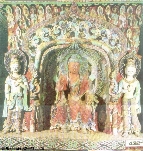 Very typical for the
presentation of Buddhist deities is the Buddha sitting in
a niche, meditating or teaching, and accomagnied by two
disciples or Bodhisattvas. Very typical for the
presentation of Buddhist deities is the Buddha sitting in
a niche, meditating or teaching, and accomagnied by two
disciples or Bodhisattvas. |
 During
late Northern Wei, the ascetic style of the Buddha made
place for a more easy minded style of Bodhisattva, like
the left Maitreya (Milefo 彌勒佛 or Mile Pusa 彌勒菩薩). During
late Northern Wei, the ascetic style of the Buddha made
place for a more easy minded style of Bodhisattva, like
the left Maitreya (Milefo 彌勒佛 or Mile Pusa 彌勒菩薩). |
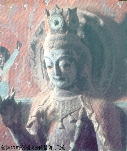 Red and green are the
main colors for Dunhuang painting. The Buddha is red
faced, the Bodhisattvas mostly have white or light green
faces, like this Northern Liang 北涼 Mile Pusa. Red and green are the
main colors for Dunhuang painting. The Buddha is red
faced, the Bodhisattvas mostly have white or light green
faces, like this Northern Liang 北涼 Mile Pusa. |
Wall paintings in Dunhuang look very
unlike mostly known Chinese art. The persons are painted
in dark colors. The left two pictures show stories from
the Buddha's life.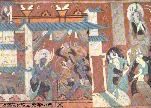 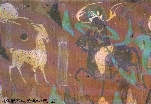 |
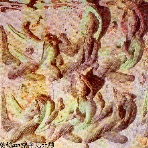 Wall decoration
behind the main statues of the Buddhist deities is
effected by wall paintings or by small figurines like the
left picture of Feitians 飛天, flying goddesses from Buddhist
heaven. Wall decoration
behind the main statues of the Buddhist deities is
effected by wall paintings or by small figurines like the
left picture of Feitians 飛天, flying goddesses from Buddhist
heaven. |
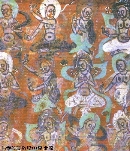 |
Wall paintings as background decorations often show a
whole army of Bodhisattvas. The left picture clearly
shows Indian influence. |
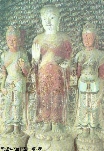 This is a good
example for a standing trinity of Buddha and
Bodhisattvas, painted with only a few colors themselves
and a richly patterned background wall. This is a good
example for a standing trinity of Buddha and
Bodhisattvas, painted with only a few colors themselves
and a richly patterned background wall. |
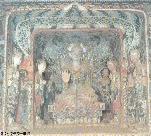 |
The old trinity is enlarged by guards and
Bodhisattvas by the end of Northern dynasties. The main
Buddha becomes smaller, the other persons taller, making
them almost equally high and important as the Buddha. |
 A
Bodhisattva from Sui Dynasty 隋. Typical for Chinese style
depicting these beings is that it is unclear from the
picture if it is a man or a woman, wiping away their
worldy features. A
Bodhisattva from Sui Dynasty 隋. Typical for Chinese style
depicting these beings is that it is unclear from the
picture if it is a man or a woman, wiping away their
worldy features. |
 |
While the later known Buddhas have a shaved, rather
fatty face, Tang Buddhas sometimes are decorated with a
moustache, a relict of Gandhara art. |
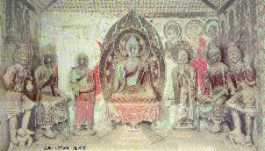 Tang time groupings
of the Buddha and his followers are not as narrowly
stuffed together like the Northern Wei groupings. Tang time groupings
of the Buddha and his followers are not as narrowly
stuffed together like the Northern Wei groupings. |
  |
Like in secular art, Tang dynasty figurines show a
well nourished person also in depicting Bodhisattvas like
the two examples to the left. |
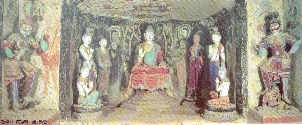 The colors of Tang
time statues are more rich then that of Northern Wei.
Blue is also integrated, and the figures look more lively
in both gesture and mimic art. The colors of Tang
time statues are more rich then that of Northern Wei.
Blue is also integrated, and the figures look more lively
in both gesture and mimic art. |
 |
A Heavenly King (Tianwang 天王) stamping a
demon to death. Detail from a Tang dynasty grotto. |
 Tang wallpaintings
also use blue colors, but the whole style with mystic
black figures is still prevalent. Bodhisattvas are more
depicted as monks with bald head. Tang wallpaintings
also use blue colors, but the whole style with mystic
black figures is still prevalent. Bodhisattvas are more
depicted as monks with bald head.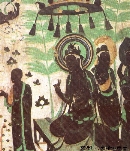 |
 |
Tang dynasty wall paintings are more rich then before.
This picture shows the Buddha riding an elephant inmidst
of lotus flowers. |
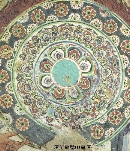 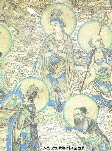 Mandalas
often decorate grotto ceilings, like the left Tang time
grotto. One of the last examples of Duhuang art is the
Manjusri Buddha (Wenshushili 文殊師利) painting, sponsored by Western Xia 西夏 rulers. Mandalas
often decorate grotto ceilings, like the left Tang time
grotto. One of the last examples of Duhuang art is the
Manjusri Buddha (Wenshushili 文殊師利) painting, sponsored by Western Xia 西夏 rulers. |
Yungang Caves
雲崗
When the Tuoba federation founded their kingdom named Dai 代 in
the north of modern Shanxi province, they were already
converted to Buddhism. The impressive religion of
Buddhism was an instrument of state control. The Tuoba
emperors, calling their empire "Northern Wei"
, saw themselves as an incarnation of the Buddha
and expressed their worldly and sacral rule by giving the
Buddha statues the face of the repective rulers. The
first capital of the Tuoba in Datong 大同 was equipped with a
large place of Buddhist worship. The outburst of digging,
carving and creating activities began around 460 AD under
the guidance of the monk Tanyao 曇曜. Stone Buddha
images were much worse to destroy then the wooden or
metal images during the Buddhist persecution some decades
before. Experienced artisans from Dunhuang were transferred
to assist the Yungang artisans. The Buddha images of
Yungang are still influenced of Middle Asian examples
from Gandhara and Bamiyan: Buddhas have curly hair
as well as bald heads, like in Central Asia. The flaming
nimbus around the Buddha is also a Central Asia feature,
like Indian flower ornaments and scenes of Shiva riding a
bull. The most popular deities under Northern Wei rule
were the historical Buddha Shâkyamuni (Shijiamouni 釋迦牟尼) and the
Bodhisattva Maitreya. |
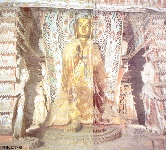 |
Many Buddha grouping in the grottoes are protected by
a roofed shrine. Some of the main Buddhas are still
covered with gold color. |
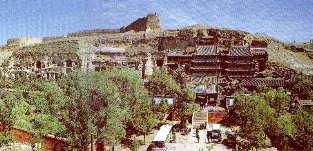 The main
entrace of Yungang Caves with an entrance hall from later
times. The main
entrace of Yungang Caves with an entrance hall from later
times. |
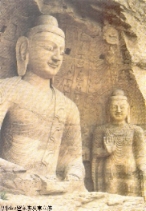 |
One of the earliest and the main Buddha statue of
Yungang Caves. It is said to be the picture of the
Northern Wei ruler, the personification of the reborn
Tathâgata Buddha. |
 The statues exposed to
sunlight have all lost their original coloring. The
Buddha sitting and making a blessing gesture, to his left
a disciple. The statues exposed to
sunlight have all lost their original coloring. The
Buddha sitting and making a blessing gesture, to his left
a disciple. |
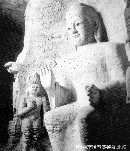 |
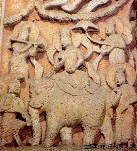 |
Buddha Shakyamuni riding an elephant, a bas-relief of
which only the red background color is left. |
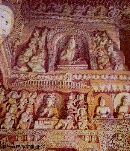 These
two pictures show the whole decoration of Yungang
grottoes, richly decorated with Bodhisattvas sitting in
small niches and facing the main Buddha of the grotto. These
two pictures show the whole decoration of Yungang
grottoes, richly decorated with Bodhisattvas sitting in
small niches and facing the main Buddha of the grotto. |
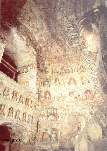 |
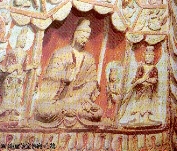 |
A Buddha group from wall bas-relief, Buddha
accompagnied by two disciples and two Bodhisattvas. |
Other wall decorations show Feitians 飛天, sexless beings
that accompany the Enlightened in the Western Paradise. |
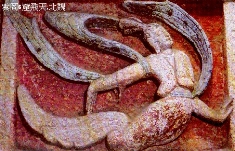 |
Longmen Caves
龍門
When the Northern
Wei Dynasty shifted her capital from Datong
to Luoyang 洛陽 in the Yellow River plain, there was also a
need to create a new place of worship and expression of
worldy rule of the Buddha emperor. Sui and Tang
emperors continued to create pictures of
Buddhas, Bodhisattvas, disciples and creatures of heaven
and hell. Especially during the reign of Empress Wu
Zetian 武則天 chiseling grottoes and statues
were put into great effect. Popular deities were now the
Buddha Amitabha (Amituofo 阿彌陀佛) and the Bodhisattva Avalokiteshvara (Guanshiyin 觀世音).
Stories of the Buddha's life and pictures of Buddha
worship by the imperial clans are often used items too.
The Longmen caved do not only present the statues of the
respective deities, but the names of the patrons or
sponsors of the images are inscribed. Members of the
imperial families (Tuoba 拓拔, Yang 楊 of the Sui and Li 李 of the
Tang) contributed to the richness of Longmen sculptures,
as well as Buddhist societies and single groups of monks
and nuns. But because the paintings and sculptures in
Longmen Caves since long have lost their coloring, they
are not as beautiful as the paintings and statues in the
Dunhuang or Yungang Caves. |
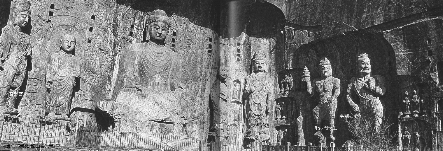 The core
of Longmen Caves is the Fengxian Monastery 奉先寺. It is marked
by a large terrace facing the Luo River. The main Buddha
is accompanied by two disciples, two Bodhisattvas and
different guards of Heaven. The core
of Longmen Caves is the Fengxian Monastery 奉先寺. It is marked
by a large terrace facing the Luo River. The main Buddha
is accompanied by two disciples, two Bodhisattvas and
different guards of Heaven. |
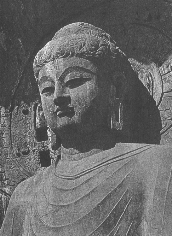 |
The main Lokeshvaraja Buddha (Da Lushenafo 大盧舍那佛) of Longmen Caves, carved
during the Tang Dynasty. |
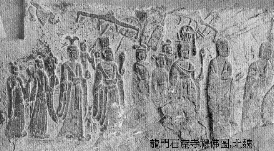 |
A procession of the Northern Wei nobility marching to
venerate the Buddha at Longmen Caves. A bas-relief that
probably once has been coloured. |
Maijishan
麥積山
This mountain near Tianshui 天水/Gansu was first used as
a Buddhist refugium at the end of 4th century. Although
Maijishan is noot as famous as the upper three caves, the
grottoes in this curious mountain contain more then 7000
Buddha and Bodhisattva steles. |
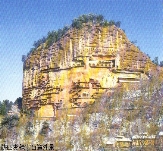 |
The Maijishan mountain is named after its shape like
a haystack. |
 The grottoes of this
mountain contain very beautiful statues of Bodhisattvas
like the left Pusa 菩薩 whose face lineaments are very soft,
almost like that of a girl. The grottoes of this
mountain contain very beautiful statues of Bodhisattvas
like the left Pusa 菩薩 whose face lineaments are very soft,
almost like that of a girl. |
| Other Buddhist Grottoes |
 |
Very famous also outside of China is the huge sitting
Buddha of Leshan 樂山 in Sichuan from
the Tang dynasty. |
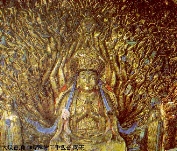 Also in Sichuan, near
Dazu 大足, is the Baoding 寶頂山
mountain with more modern sculptures like this example of
a thousand hand Guanyin 觀音 Bodhisattva of Mercy. Also in Sichuan, near
Dazu 大足, is the Baoding 寶頂山
mountain with more modern sculptures like this example of
a thousand hand Guanyin 觀音 Bodhisattva of Mercy. |
| Famous Buddhist caves are spread all over
China. Without giving examples of their art style, only
their names should be mentioned here: Bingling
monastery 炳靈寺 near Yongjing 永靖/Gansu and the Northern Caves
北石窟 of Qingyang 慶陽/Gansu, the Thousand
Buddha Cliff 千佛崖 at Guangyuan
廣元, the Mingshan 茗山 mountain in Anyue
安岳/Sichuan, Gongxian 鞏縣 in Henan province, Xumi
須彌/ Ningxia, and 克孜爾 Kezier (Bezeklik) in Xinjiang
province. |